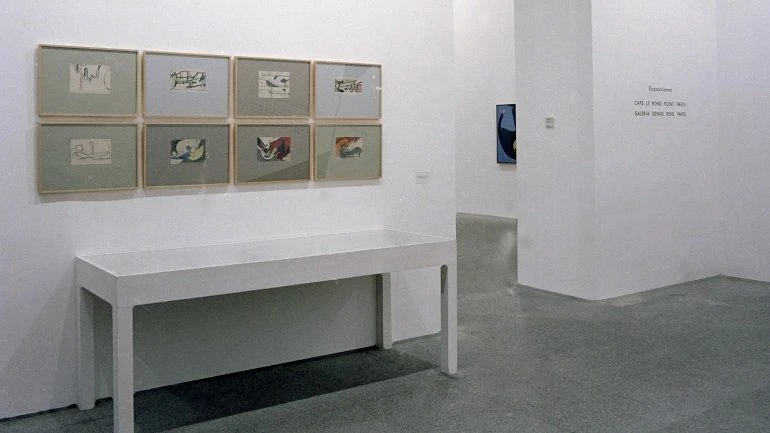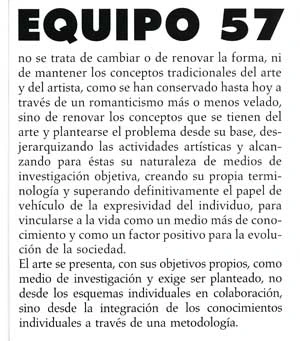Equipo 57

In 1957 the group makes public, through a manifesto, their artistic purposes: the denunciation of production and market mechanisms, the desire to renew the current artistic situation and the search for a social function to art and the integration of the artist in society. With this they are part of an activist attitude that is characteristic of these avant-garde groups and - in the words of Ángel Llorente - their work "shows the alternative that led the Equipo: the defence of a new artistic behaviour in society. An assumed social commitment, although there are some contradictions, regarding the artistic practice of geometric abstraction." To carry out these objectives, this group became interested in rationalistic and analytical tendencies which carried the strong stamp of scientific approaches.
The beginnings of Equipo 57 are intertwined with painting and a consequent artistic theory. As noted by Llorente, from painting and its theoretical production its members move onto sculpture and architecture as a logical consequence of their research on the physical and architectural space (based on surfaces) and interactivity of the artistic space.
The exhibition is organised chronologically into five parts related to the exhibitory biography of the group: 1. Café Le Rond Point (Paris), Denise René Gallery (Paris) Sala Negra (Madrid) 2. Thorvaldsen Museum Exhibition (Copenhagen), 3. Club Urbis (Madrid) 4. Sala Darro (Madrid), and 5. Céspedes Gallery (Cordoba), Susanne Bollag Gallery (Zurich). To these, there is a sixth part added dedicated to the members of Equipo 57’s designs, which shows the more important examples of urban and domestic furniture (chairs, benches and stools, lamps and tables), as in Banco (Edición Darro) of 1960 or the Lámpara de elementos combinables (1962). All of them demonstrate the perfect combination between theory and practice from Equipo 57, with works they produced together and that they considered experimental work that was susceptible to industrial design and urban planning. This position involves both the reintegration of the arts to trade and social intervention through art. In addition, the nearly eighty works that have been collected allow us to visualise the proximity of Team 57 to other contemporary practices such as Concrete Art and Kinetic Art.
Artists
Sala Rekalde, Bilbao (March 1 - April 24, 1994); Palacio de Exposiciones y Congresos, Córdoba (May 4 - June, 1994); Auditorio de Galicia, Santiago de Compostela (September 10 - October 23, 1994); Musée d'Art et d'Histoire, Cholet, France (October - November, 1994)
Organised by
Museo Nacional Centro de Arte Reina Sofía
Image gallery

Itinerary
Museo Nacional Centro de Arte Reina Sofía, Madrid
14 September, 1993 - 8 November, 1993
Sala Rekalde, Bilbao
1 March, 1994 - 24 April, 1994
Palacio de Exposiciones y Congresos, Córdoba
4 May, 1994 - 5 June, 1994
Auditorio de Galicia, Santiago de Compostela
10 September, 1994 - 23 October, 1994
Musée d'Art et d'Histoire, Cholet, Francia
31 October, 1994 - 30 November, 1994
